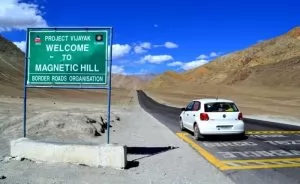Who isn’t fascinated by the miracles of nature? If you too love the idea of them and wish to experience some of nature’s best wonders, Magnetic Hill in India would be the right choice for your next adventure. This place is especially recommended for those who are planning a trip to Leh Ladakh.

So, what’s so special about this place? Well, the Magnetic Hill in Leh is famous for its gravity-defying occurrence. As a natural phenomenon, gravity attracts things towards the earth, which means they fall downwards when let free. However, at this majestic destination, objects appear to be moving uphill when let free. So, what is the explanation for this? Let’s start with geography.
Magnetic Hill lies somewhere along the Leh-Kargil-Srinagar National Highway in the Trans-Himalayan region at an altitude of 14,000 feet. Sindhu river flows to the east of the hill, making it a scenic location to capture photographs. All Leh Ladakh travellers would agree that Magnetic Hill is one of the best places to visit in Leh Ladakh.
In your travels around Leh-Ladakh, you will come across fascinating sights which arouse your curiosity to no end. One such sight attraction is Magnetic Hill, the place where gravity takes a backseat. Lying at a distance of around 30 km from Leh, the Magnetic Hill is marked by a yellow signboard which reads “The Phenomenon That Defies Gravity”. It also instructs you to park your vehicles in the box marked with a white point on the road, which is known as the Magnetic Road. When parked at the indicated spot, vehicles begin moving forward at a speed of almost 20km/h.
Where Is It?
The distance from Leh to Magnetic Hill is around 30 km. It is marked by a yellow signboard that reads “The Phenomenon That Defies Gravity”. There is a white marked box on the road to park your vehicle inside it. When parked in neutral at the indicated spot, vehicles begin moving forward at a speed of almost 20 km/h. The road along which the vehicles move is known as Magnetic Road.

More About It
Magnetic Hill in Ladakh, India is a sibling to Mount Aragat in Armenia. Mount Aragat, just like the Magnetic Hill, seems to be going upwards when it is actually going downhill. This mysterious phenomenon has created a lot of buzz and attracts tourists every month who come to find explanations for the occurrence. The locals too have interesting stories to tell about Magnetic Hill in India that make this phenomenon all the more riveting.
Theories Behind the Phenomenon
There are a number of theories surrounding the Magnetic Hill in India. Some of them hold logic and some are stories told by those who live there. However, all these are theories and we don’t know for sure if they are true.
The Stories from Locals
Residents believe this road to be a literal stairway to heaven. It’s their belief that the road was once used to send the doers of good deeds or ‘karma’ to heaven. As for those who failed their karma, they never found their way to the land above. Other than this theory, here are two compelling theories that can resolve the mystery of the Magnetic Hill in India and its upward movement.

The Magnetic Force Theory
The most popular one, yet not proven, is the theory which says that the hill has a strong magnetic force emanating from within, as a result of which it pulls vehicles in the vicinity towards it. It is also said that the magnetic force in the area is so strong that fighter planes of the Indian Air Force exclude the route around the Hill in Leh from their flight plans so that they don’t face magnetic interference on their devices. This has been experienced and testified by many travellers from across the world.
The Optical Illusion Theory
As awe-inspiring as it sounds, the Magnetic Force Theory has never been verified by scientists, and according to a few researchers, a more widely accepted theory (and the most likely one) is the Optical Illusion Theory. This theory says that the Magnetic Hill in Leh is a “Cyclops Hill” that has no magnetic force emanating from within; rather, it is just an optical illusion. According to this theory, this Hill looks like an upwards slope, but in reality, it goes downhill and it is an optical illusion that makes it look like an upslope. So, when you see the vehicle going uphill, it is actually going downhill.












